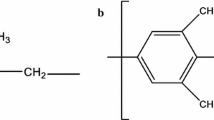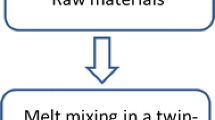Abstract
The thermal behavior, morphology, ester-interchange reaction of Poly(trimethylene terephthalate) (PTT)/Poly(ethylene terephthalate) (PET) melt blends were investigated over the whole composition range(xPTT/(1-x)PET) using a twinscrew Brabender. The melt blends were analyzed by differential scanning calorimetry (DSC), nuclear magnetic resonance spectroscopy (13C-NMR), and scanning electron microscopy (SEM). Single glass transition temperature (T g ) and cold crystallization temperature (T cc ) were observed in all melt blends. Melt blends were found to be due to the ester-interchange reaction in PTT/PET blend. Also the randomness of copolymer increases because transesterification between PTT and PET increases with increasing blending time. This reaction increases homogeneity of the blends and decreases the degree of crystallinity of the melt blends. In PTT-rich blends, mechanical properties decrease with increase of PET content compared with that of pure PTT. And, in PET-rich blends, tensile modulus decreases with increase of PTT content, but tensile strength and elongation is similar to that of pure PET.
Similar content being viewed by others
References
S. Zheng, J. Huang, Y. Li, and Q. Guo,J. Polym. Sci., Part B, Polym. Phys.,35, 1383 (1996).
M. M. Coleman, C. J. Serman, D. E. Bhagwagar, and P. C. Painter,Polymer,31, 1187 (1990).
T. W. Son, S. K. Lim, D. W. Lee, and E. W. Lee,J. Appl. Polym. Sci.,73, 1049 (1999).
T. R. Nassar, D. R. Paul, and J. W. Barlow,J. Appl. Polym. Sci.,23, 85 (1979).
Y. Aoki, L. Li, T. Amari, K. Nishimura, and Y. Arashiro,Macromolecules,32, 1923 (1999).
G. Montaudo, C. Puglisi, and F. Samperi,Macromolecules,31, 650 (1998).
S. P. Mishra and B. L. Deopura,J. Appl. Polym. Sci.,33, 759 (1987).
M. Pyda, A. Boller, J. Grebowicz, B. V. Lebedev, and B. Wunderlich,J. Polym. Sci., Part B, Polym. Phys.,36, 2499 (1998).
S. P. Dandurand, S. Perez, J. F. Revol, and F. Brisse,Polymer,20, 419 (1979).
K. Pang, P. R. Oh, J. C. Kim, and Y. H. Kim,Proc. Korean Textile Conference (Autumn), 303 (1999).
D. R. Paul and S. Newman, “Polymer blends”, pp.1–14, Academic Press, New York, 1978.
P. C. Painter, S. L. Shenoy, D. E. Bhagwagar, J. Fishburn, and M. M. Coleman,Macromolecules,24, 5623 (1991).
S. Spera, R. Po, and L. Abis,Polymer,37, 729 (1996).
S. C. E. Backson, A. M. Kenwright, and R. W. Richards,Polymer,36, 1991 (1995).
Author information
Authors and Affiliations
Corresponding author
Rights and permissions
About this article
Cite this article
Son, T.W., Kim, K.I., Kim, N.H. et al. Thermal properties of Poly(trimethylene terephthalate)/Poly(ethylene terephthalate) melt blends. Fibers Polym 4, 20–26 (2003). https://doi.org/10.1007/BF02899325
Received:
Revised:
Accepted:
Issue Date:
DOI: https://doi.org/10.1007/BF02899325




